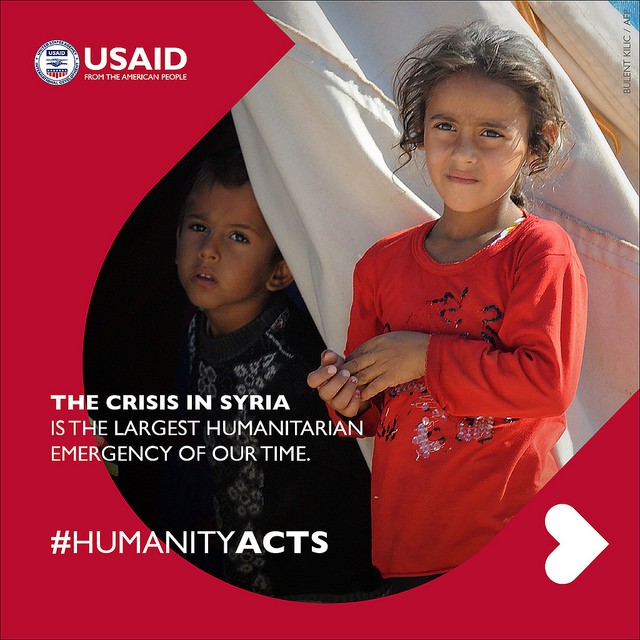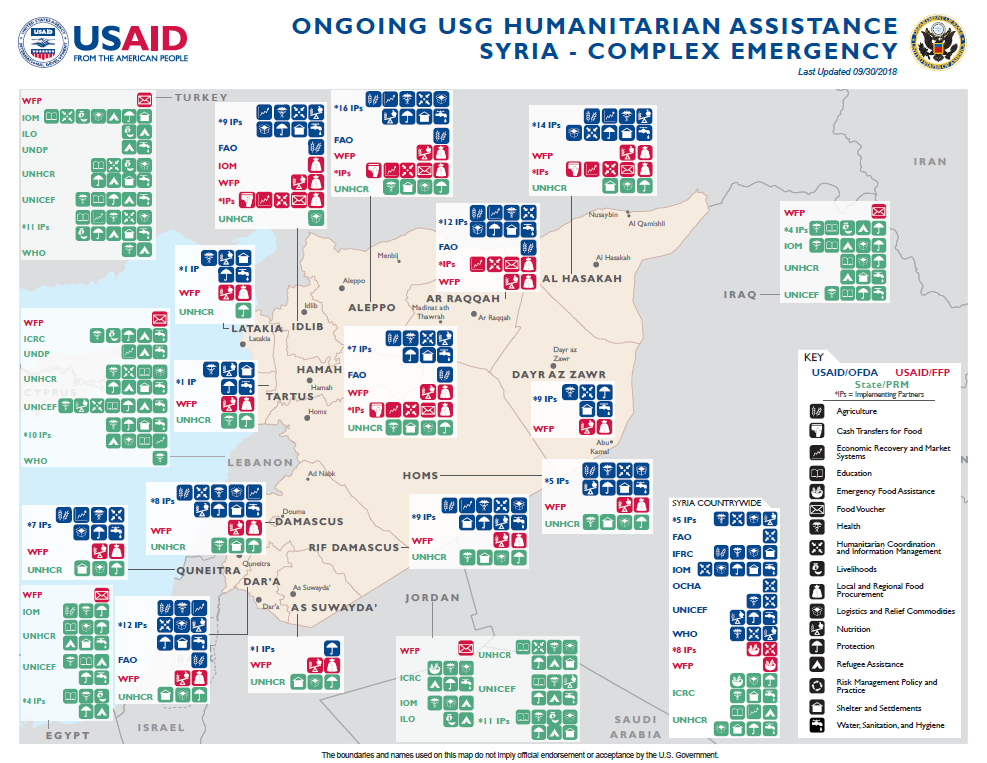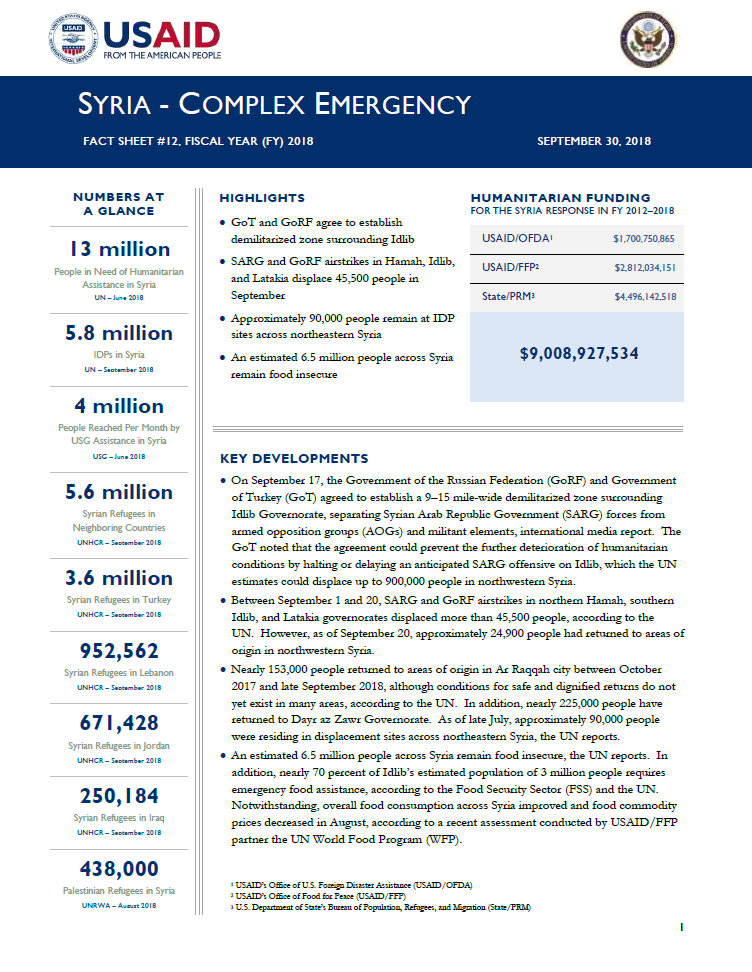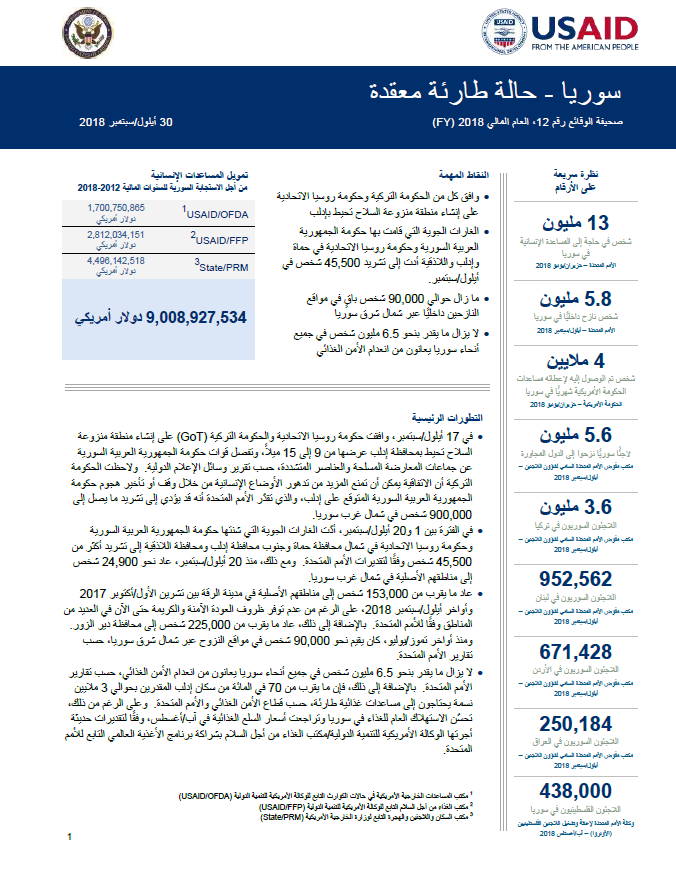- What We Do
- Agriculture and Food Security
- Democracy, Human Rights and Governance
- Economic Growth and Trade
- Education
- Environment and Global Climate Change
- Gender Equality and Women's Empowerment
- Global Health
- Humanitarian Assistance
- Transformation at USAID
- Water and Sanitation
- Working in Crises and Conflict
- U.S. Global Development Lab
Speeches Shim
September 30, 2018
Highlights
GoT and GoRF agree to establish demilitarized zone surrounding Idlib
SARG and GoRF airstrikes in Hamah, Idlib, and Latakia displace 45,500 people in September
Approximately 90,000 people remain at IDP sites across northeastern Syria
An estimated 6.5 million people across Syria remain food insecure
Key Developments
On September 17, the Government of the Russian Federation (GoRF) and Government of Turkey (GoT) agreed to establish a 9–15 mile-wide demilitarized zone surrounding Idlib Governorate, separating Syrian Arab Republic Government (SARG) forces from armed opposition groups (AOGs) and militant elements, international media report. The GoT noted that the agreement could prevent the further deterioration of humanitarian conditions by halting or delaying an anticipated SARG offensive on Idlib, which the UN estimates could displace up to 900,000 people in northwestern Syria.
Between September 1 and 20, SARG and GoRF airstrikes in northern Hamah, southern Idlib, and Latakia governorates displaced more than 45,500 people, according to the UN. However, as of September 20, approximately 24,900 people had returned to areas of origin in northwestern Syria.
Nearly 153,000 people returned to areas of origin in Ar Raqqah city between October 2017 and late September 2018, although conditions for safe and dignified returns do not yet exist in many areas, according to the UN. In addition, nearly 225,000 people have returned to Dayr az Zawr Governorate. As of late July, approximately 90,000 people were residing in displacement sites across northeastern Syria, the UN reports.
An estimated 6.5 million people across Syria remain food insecure, the UN reports. In addition, nearly 70 percent of Idlib’s estimated population of 3 million people requires emergency food assistance, according to the Food Security Sector (FSS) and the UN. Notwithstanding, overall food consumption across Syria improved and food commodity prices decreased in August, according to a recent assessment conducted by USAID/FFP partner the UN World Food Program (WFP).
Syria Complex Emergency - Map #12 FY18 ![]() (pdf - 463k)
(pdf - 463k)
Numbers At A Glance
13 million
5.8 million
4 million
5.6 million
3.6 million
952,562
671,428
250,184
438,000
Humanitarian Funding
To Syria Humanitarian Response
FY 2012 - FY 2018
| USAID/OFDA | $1,700,750,865 |
| USAID/FFP | $2,812,034,151 |
| State/PRM | $4,496,142,518 |
| TOTAL | $9,008,927,534 |
Syria Complex Emergency - Fact Sheet #12 FY18 ![]() (pdf - 267k)
(pdf - 267k)
سوريا حالة طوارئ معقدة ![]() (pdf - 616k)
(pdf - 616k)
INSECURITY, DISPLACEMENT, AND HUMANITARIAN ACCESS
From January–August, approximately 987,000 internally displaced persons (IDPs) returned to areas of origin in Syria, while 18,000 Syrian refugees in neighboring countries returned to Syria, according to the UN. However, as of September, approximately 5.8 million people remained internally displaced and an additional 5.6 million people continued to seek refuge in neighboring countries.
Conflict in Syria killed at least 192 civilians in Syria during September, contributing to a total of 6,228 civilian deaths since the start of 2018, according to the Syria Network for Human Rights (SNHR). SARG and GoRF military operations killed 95 people during that time period, SNHR reports. The organization reported the highest number of deaths during September in Dayr az Zawr, followed by Hamah and Idlib.
Northwestern Syria
On September 17, the GoRF and GoT agreed to establish a 9–15 mile-wide demilitarized zone surrounding Idlib, separating SARG forces from AOGs and militant elements, international media report. The GoRF and GoT plan to establish the zone by October 15, and stipulated the withdrawal of militant groups, including Hayat Tahrir al-Sham, by that date; the deal specifies the removal of AOG heavy weaponry by October 10. The GoT indicated that the agreement could prevent a severe deterioration in humanitarian conditions by halting or delaying an anticipated SARG offensive on Idlib, which the UN estimates could displace up to 900,000 people in northwestern Syria.
From September 1–20, SARG and GoRF airstrikes in northern Hamah, southern Idlib, and Latakia displaced more than 45,500 people, primarily to Idlib’s northwestern Badama, northern Dana, and Darkosh sub-districts, as well as Aleppo Governorate’s Afrin District, according to the UN. Approximately 24,900 people had returned to areas of origin in northwestern Syria as of September 20.
As of August, approximately 1.9 million IDPs were residing in northwestern Syria, of which nearly 418,000 people were sheltering in nearly 340 IDP settlements, according to the UN. In August, State/PRM partner the Office of the UN High Commissioner for Refugees (UNHCR) provided relief commodities to nearly 9,300 newly displaced persons and shelter kits to nearly 700 people in Aleppo and Idlib. The Protection Cluster also provided psychological first aid, psychosocial support, and gender-based violence risk education to more than 1,900 IDPs in Idlib, the UN reports.
Northeastern Syria
Despite continued unexploded ordnance contamination, nearly 153,000 people have returned to Ar Raqqah city since late 2017, with many IDPs citing poor conditions, movement restrictions, and lack of income opportunities at IDP sites as motivation for return, the UN reports. In addition, nearly 225,000 people have returned to Dayr az Zawr since late 2017. Approximately 90,000 people were residing in IDP sites across northeastern Syria as of late July, the UN reports.
From late July to late September, approximately 27,000 people fled Islamic State of Iraq and Syria (ISIS)-held areas in southern Dayr az Zawr due to a U.S.-backed Syrian Democratic Forces (SDF) military offensive to retake the area, according to the UN. Many newly displaced individuals relocated to makeshift settlements in SDF-controlled areas within the governorate and continue to require humanitarian assistance, the UN reports. As of late September, approximately 15,000 people remained in ISIS-held areas of Dayr az Zawr with limited access to humanitarian assistance and basic services.
The availability of basic services has gradually improved in Ar Raqqah city, with at least six hospitals operational as of June. However, populations continue to experience difficulties accessing primary health care, nutrition, and obstetric and newborn care services, the UN reports. Additionally, a June UN assessment identified limited availability of basic services in Dayr az Zawr, with relief agencies reporting primary health care services and shelter as essential needs in nearly 50 percent of assessed locations.
Central Syria
As of mid-August, only four of eight IDP sites in Rif Damascus Governorate remained open, sheltering approximately 6,400 people displaced from the governorate’s Eastern Ghouta region, as well as IDPs from Idlib’s formerly besieged towns of Foah and Kafraya, the Shelter Cluster reports. From January–August, the cluster rehabilitated collective shelters and installed shelter kits and tents, benefiting more than 86,300 people in Rif Damascus.
HEALTH AND WASH
From late June to late August, health workers identified approximately 500 typhoid cases in Al Hasakah Governorate, including nearly 350 typhoid cases in the governorate’s Areesheh camp, according to U.S. Government (USG) partner the UN World Health Organization (WHO). In response to the new typhoid cases, WHO has deployed health teams to conduct health, hygiene, and sanitation campaigns in five IDP camps in Al Hasakah.
On August 26, approximately 500 people in Ar Raqqah city were hospitalized after reportedly consuming contaminated water, the UN reports. Humanitarian organizations are procuring six water pumps, conducting sanitation awareness campaigns, and providing chlorination supplies to vulnerable populations in the city.
In August, USG partner the UN Children’s Fund (UNICEF) improved access to safe drinking water for nearly 700,000 people across Syria through water, sanitation, and hygiene (WASH) interventions, including constructing wells, rehabilitating water and sanitation facilities, conducting hygiene promotion campaigns, and water trucking operations.In Dar’a Governorate, UNICEF repaired more than 30 wells, providing approximately 90,000 people with safe drinking water, and distributed hygiene supplies to 32,500 people in Dar’a city during the month. In addition, UNICEF provided safe drinking water to approximately 77,000 people at three Aleppo IDP sites through water trucking operations in August. USAID/OFDA provided nearly $26.1 million in FY 2018 to UNICEF to support critical WASH interventions.
With more than $79.8 million in FY 2018 funding, USAID/OFDA improved vulnerable populations’ access to health care by supporting health facilities and mobile clinics, providing medical supplies, training medical personnel, and vaccinating children ages five years and younger across Syria. USAID/OFDA also provided more than $56.4 million to implementing partners to conduct hygiene awareness campaigns, distribute safe drinking water, provide WASH commodities, and rehabilitate water supply and sanitation systems in IDP sites and conflict-affected communities.
UNICEF continues to provide health care and safe drinking water to an estimated 45,000 people residing at the informal Rukban settlement—located along the Syria–Jordan border berm. Between January and September, UNICEF provided more than 9,100 medical consultations and 20 liters of safe drinking water per person daily to Rukban residents. In August, UNICEF supported the treatment of nearly 1,420 children ages five years and younger and the routine immunizations of nearly 780 children at the area’s UN-managed clinic. In addition, health workers at the clinic screened nearly 950 children and 1,200 pregnant and lactating women for acute malnutrition, identifying and treating six children experiencing severe acute malnutrition (SAM) and nearly 20 children experiencing moderate acute malnutrition during the month.
FOOD SECURITY AND NUTRITION
Approximately 6.5 million people across Syria remain food insecure, while nearly 70 percent of Idlib’s population of 3 million people requires emergency food assistance, according to the UN and FSS. In Idlib’s Dana, Khan Shaykun, and Sanjar sub-districts, where approximately 501,000 people reside, populations are facing Emergency—IPC 4—levels of food insecurity.4 Humanitarian organizations lack access to Sanjar and report that potential military operations could disrupt access to Khan Shaykun. In addition, the sector reports that food security conditions could deteriorate in Dana and Sanjar as conflict in surrounding areas of Idlib drives IDPs to the sub-districts. In anticipation of deteriorating security conditions and hindered humanitarian access in Idlib, food security organizations developed a preparedness plan to provide emergency food assistance, as well as monthly food rations and cash-based transfers for food, sufficient to meet the needs of 1.4 million people for three months.
Despite continued food insecurity, overall food consumption improved across Syria in August, particularly in UN-designated hard-to-reach areas of Aleppo, Hamah, and Homs governorates, where improved access has increased the quantity of food available to local populations, according to a recent WFP assessment. While fewer households reported utilizing negative coping strategies to meet food needs in August, the severity of coping strategies among assessed households increased, with the highest rates noted in Dar’a.
As security conditions stabilize and access increases countrywide, food commodity prices are decreasing and stabilizing at affordable and similar levels across governorates, WFP reports. Average prices of wheat, rice, and bulger decreased by 8, 7, and 3 percent, respectively, since February, while countrywide government-subsidized bread prices decreased by 16 percent between July and August, reaching a record low since late 2016, WFP reports.
In August, USAID/FFP partner WFP reached more than 2.9 million people in Syria, including approximately 549,000 people in Aleppo, Idlib, and Hamah, with food assistance. In addition, WFP dispatched emergency food rations to more than 197,000 people across more than 30 UN-identified hard-to-reach areas in Aleppo, Ar Raqqah, Dar’a, Dayr az Zawr, Homs, Quneitra, and Rif Damascus governorates. In preparation for potential escalation of conflict in Idlib, WFP also pre-positioned emergency food assistance sufficient to feed 1 million people for up to 30 days. In FY 2018, USAID/FFP contributed more than $238 million to support WFP efforts in Syria.
WFP distributed emergency food assistance—including household food rations, nutrition supplies, ready-to-eat rations, and wheat flour—to nearly 396,000 people in Dar’a, Quneitra, and As Suwayda’ governorates from July–August. WFP also provided household food rations to nearly 37,800 people in Eastern Ghouta in August.
UNICEF estimates that more than 3 million children ages five years and younger require nutrition support in Syria, including 20,000 children experiencing SAM. Between January and June, UNICEF screened approximately 1.7 million children for acute malnutrition, identifying and treating 8,200 children experiencing SAM. Additionally, WFP distributed nutrition supplies for the prevention of acute malnutrition for more than 121,000 children across 12 governorates in August.
REFUGEE ASSISTANCE
WFP reached 3 million Syrian refugees in Egypt, Iraq, Jordan, Lebanon, and Turkey with emergency food and cashbased assistance in August. The number assisted includes 1.5 million Syrian refugees in Turkey, more than 687,000 Syrian refugees and host community members in Lebanon, more than 648,000 people in Jordan, approximately 80,700 individuals in Egypt, and approximately 53,200 refugees in Iraq, the UN agency reports. In FY 2018, USAID/FFP provided approximately $191 million to WFP to provide food vouchers to Syrian refugees in the region.
PUBLIC DONATION INFORMATION
The most effective way people can assist relief efforts is by making cash contributions to humanitarian organizations that are conducting relief operations. A list of humanitarian organizations that are accepting cash donations for disaster responses around the world can be found at www.usaid.gov/crisis/syria.
The USG encourages cash donations because they allow aid professionals to procure the exact items needed (often in the affected region); reduce the burden on scarce resources (such as transportation routes, staff time, and warehouse space); can be transferred very quickly and without transportation costs; support the economy of the disaster-stricken region; and ensure culturally, dietary, and environmentally appropriate assistance.





Comment
Make a general inquiry or suggest an improvement.